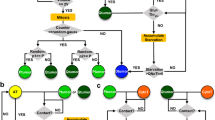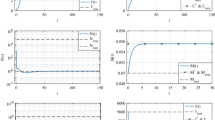Abstract
In this work, we characterize the viability kernel of a two-dimensional dynamical system describing the interaction between tumor cells and effector cells, controlled by chemotherapy and immunotherapy, subjected to biological constraints. We use viability theory to calculate analytically the viability kernel that measures the relevance of combination therapy based on the condition of the cells during the first diagnosis and evaluate the chances of remission of a patient.
Access this chapter
Tax calculation will be finalised at checkout
Purchases are for personal use only
Similar content being viewed by others
References
J.-P. Aubin, Viability Theory (Birkhauser Boston, New York, 2009). 1991 Edition
G. Deffuant, S. Martin, L. Chapel, Utiliser des “support vector machines” pour apprendre un noyau de viabilité. MajecSTIC 2005: Manifestation des Jeunes Chercheurs francophones dans les domaines des STIC, IRSA - IETR - lSTI, Nov 2005, Rennes, pp. 195–202
L.G. de Pillis, W. Gu, K.R. Fister, T. Head, K. Maples, T. Neal, A. Murugan, K. Yoshida, Chemotherapy for tumors: an analysis of the dynamics and a study of quadratic and linear optimal controls. Math. Biosci. 209, 292–315(2006)
R. Jaroudi, G. Baravdish, F. Åström, B.T. Johansson, Source Localization of Reaction-Diffusion Models for Brain Tumors (Springer, Cham, 2016), pp. 414–425
Kaviar homepage (2012). http://http://www.kaviar.prd.fr/
V.A. Kuznetsov, I.A. Makalkin, M.A. Taylor, A.S. Perelson, Nonlinear dynamics of immunogenic tumors: parameter estimation and global bifurcation analysis. Bull. Math. Biol. 56, 295–321 (1994)
A. Lorz, T. Lorenzi, J. Clairambault, A. Escargueil, B. Perthame, Effects of space structure and combination therapies on phenotypic heterogeneity and drug resistance in solid tumors. Bull. Math. Biol. 77(1), 1–22 (2015)
C. Taramasco, K. Figueroa, J. Demongeot, Estimation of life expectancy of patients diagnosed with the most common cancers in the Valparaiso Region. Ecancermedicalscience 11, 713 (2017)
Author information
Authors and Affiliations
Editor information
Editors and Affiliations
Rights and permissions
Copyright information
© 2019 Springer Nature Switzerland AG
About this chapter
Cite this chapter
Sabir, S., Raissi, N. (2019). Analysis of Tumor/Effector Cell Dynamics and Decision Support in Therapy. In: Mondaini, R. (eds) Trends in Biomathematics: Mathematical Modeling for Health, Harvesting, and Population Dynamics. Springer, Cham. https://doi.org/10.1007/978-3-030-23433-1_11
Download citation
DOI: https://doi.org/10.1007/978-3-030-23433-1_11
Published:
Publisher Name: Springer, Cham
Print ISBN: 978-3-030-23432-4
Online ISBN: 978-3-030-23433-1
eBook Packages: Mathematics and StatisticsMathematics and Statistics (R0)




